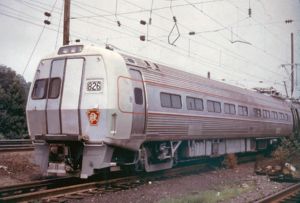Metroliner
| Amtrak Northeast Corridor services |
| The Acela brand |
| Acela Express |
| Regional (including Virginia and NHV-SPG) |
| Former services: Clocker - Metroliner |
| Other Amtrak trains on the NEC: Cardinal - Carolinian - Crescent Keystone - Palmetto - Pennsylvanian Silver Meteor - Silver Star - Vermonter |
| Commuter services on the NEC: MBTA - SLE - MNRR - NJT SEPTA R7 - SEPTA R2 - MARC |

Metroliner was a premium express train service run by Amtrak between Washington, D.C., and New York City in the United States from 1968 to 2006, with first-generation self-powered cars being replaced by new (although somewhat idential looking) locomotive-powered consists in the early-1980s. The train offered reserved business class and first class seating. A trip between New York's Pennsylvania Station and Washington, D.C.'s Union Station took 3 hours. Amtrak has replaced Metroliner service with Acela Express trainsets, and to this end, Metroliner service was discontinued on 27 October 2006. The equipment transfered to Amtrak's non-Acela services in the Northestern US where it was badly needed. However, ironically, in the same month that it discontinued Metroliner service (October 2006), 9 original 1960s-era ex first-generation Metroliner cars that had been out of service for 25 years were put back into service on the Keystone line. These cars look almost identical to Amtrak's newer Amfleet cars and have been completely refurbished. On Amtrak Keystone service (New York City and Philadelphia to Harrisburg, PA), they now serve as the last car (first car if the locomotive is pushing the train), and their addition eliminated the need the turn the train around at the end of the route, since the former Metroliner car allows the locomotive to push the train because the legacy Metroliner equipment contains an engineer's control station on one end. They are now the oldest cars operating in regular service in the Amtrak fleet. They are also the only single-level revenue cars still operating that were originally delivered to an Amtrak predecessor railroad. (A small number of ex-Santa Fe "Hi-Level" lounges and coaches remain in service on the Heartland Flyer and Coast Starlight, while baggage car service on most Amtrak long-distance trains are provided by Heritage Fleet cars rebuilt from coaches originally delivered to Amtrak-predecessor railroads.)
Contents
History
The High Speed Ground Transportation Act of 1965 started a U.S. Government effort to develop a high speed train for Northeast Corridor service. The U.S. Department of Transportation worked with the Pennsylvania Railroad, Budd Company, General Electric and Westinghouse to develop a Multiple unit high speed passenger train with initial service target for 1967.
After several setbacks, Metroliner service started on January 16, 1969, operated by Penn Central Transportation, successor to the Pennsylvania Railroad. The initial trip between New York and Washington took 2:59, 36 minutes faster than the previous best. The train consisted of six cars; 2 club cars and six snack bar coaches, full coaches weren't added until October. By April of 1969 the fastest scheduled train took 2:30 running at 125 mph.
The Metroliner was wildly successful, some trains having three times as many people trying to buy tickets as there were seats. With the creation of the National Railroad Passenger Corporation in 1971, the Metroliner trains were transferred to Amtrak.
During the prolonged labor strike at Eastern Shuttle many passengers defected to the Metroliner service.
With the increasing popularity of the faster and more modern Acela Express, the last Metroliner service operated on Friday 27 October, 2006.[1]
First generation train
The original electric multiple-unit (self-powered) trains built under the mid-1960s contracts were retired from service in the first part of the 1980s and repaced with a locomotive hauled design. Many of the first generation Metroliner cars were scrapped, but some have been preserved in museums, while others were de-engined for use elsewhere on the Amtrak system as cab cars; later, as push-pull service came into public question after a number of high-profile wrecks, these cars' cabs were deactivated and they were used interchangeably with standard coaches. Six more were depowered in 2006, after 25 years of storage, for use as cab cars between Philadelphia and Harrisburg.
Second generation train
Metroliner service from the early-1980s to 2006 consisted of AEM-7 locomotives pulling conventional Amfleet I and II coaches (the design of the coaches is derived from the first generation Metroliner design).
Expanded Metroliner service was initiated by Amtrak when issues developed with the Acela Express trainset braking systems. As trainsets were repaired, the number of Metroliner service trains declined to the current level, then were discontinued and the fleet used elsewhere in the Amtrak system.
Station stops
The last schedule in effect for the Metroliner (effective April 24, 2006), which consisted of one weekday round-trip Metroliner train (2300 northbound departing Washington at 10:00 AM; 2301 southbound departing New York at 6:00 PM) made the following station stops:
References
- ↑ Amtrak to run last Metroliner. Trains.com (2006-09-08). Retrieved on 2006-09-08.
